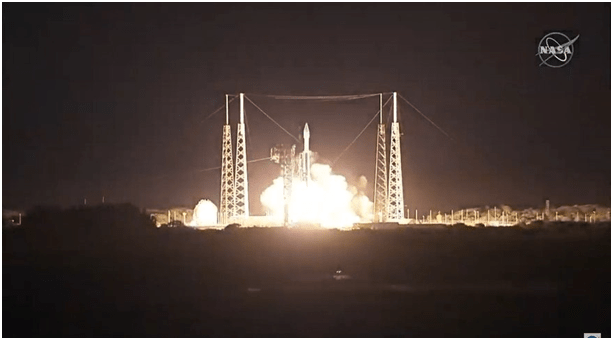Europe’s intrepid Solar Orbiter probe has lifted off on its quest to study the Sun from close quarters. The €1.5bn (£1.3bn) mission is packed with cameras and sensors that should reveal remarkable new insights on the workings of our star.
“Solar Orbiter will address big questions in Solar System science to help us understand how our star creates and controls the giant bubble of plasma that surrounds the whole Solar System and influences the planets within it. It is an ESA mission with strong NASA participation”, as stated on the official website of European space agency.
The 3,790-lb. (1,800 kilograms) spacecraft lifted off atop a United Launch Alliance (ULA) Atlas V rocket, rising off a pad at Space Launch Complex 41 here at Cape Canaveral Air Force Station on Sunday (Feb. 9) at 11:03 p.m. EST (0403 GMT on Feb. 10). The veteran launcher flew in a unique configuration featuring a 13-foot-wide (4 meters) fairing and a single solid rocket booster.
Solar Orbiter separated from the rocket as planned 53 minutes after lift-off. And, a few minutes later, the mission team had established communications with the spacecraft. So this launch, the first of the year for ULA, seemed to go swimmingly.
Solar Orbiter is collaboration between the European Space Agency (ESA) and NASA. The mission is expected to return unprecedented data and images, as well as our first views of the sun’s Polar Regions, and the team of people behind it are thrilled.
“Whenever you launch something, it’s incredibly exciting,” GüntherHasinger, ESA’s director of science, told Space.com. “The biggest relief comes when you see the light from the rocket and then when the sounds waves hit you.”
“This mission is such a treasure and important to science, we all want it to go well,” he added.
ESA is leading the Solar Orbiter mission, with NASA paying for the launch vehicle and one of the 10 instruments on board. NASA’s total monetary contribution to the mission is roughly $386 million, with ESA contributing $877 million out of a grand total cost of around $1.5 billion. (García told Space.com that the participating research institutions and universities were not required to disclose how much each of the individual instruments cost.)
Solar Orbiter was designed to study the sun up close. Its main goal is to answer the question: How does the sun create and control the heliosphere, the huge protective bubble that surrounds our solar system — and why does that bubble change over time?
Scientists believe the key to answering that question lies in the sun’s Polar Regions. Solar Orbiter will be the first spacecraft to image this enigmatic region. “We believe this area holds the keys to unravelling the mysteries of the sun’s activity cycle,” Daniel Müller, ESA’s Solar Orbiter project scientist said.
It’s a similar route to one that another NASA spacecraft took towards the Sun two years ago. In 2018, NASA launched a solar-bound spacecraft called the Parker Solar Probe, which has gotten closer to the Sun than any human-made vehicle has come before. The mission has already gathered valuable data about the Sun that is better shaping our understanding of how the celestial body works. Like most other solar vehicles, the Parker Solar Probe is orbiting in line with the planets and it’s not equipped with a camera. Solar Orbiter will be able to complement that mission with its unique route and instruments.
Solar Orbiter will cruise toward the sun, completing a few passes of Venus on its way to study our star up close. Preliminary science measurements are expected as early as May, with full science operations commencing in November 2021 when the craft’s imagers come online.





